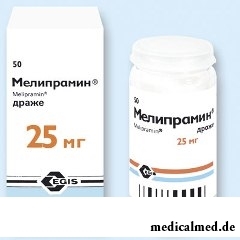





Melipraminum
Application instruction:
 Melipraminum – drug with antidepressive action.
Melipraminum – drug with antidepressive action.
Form of release and structure
Dosage forms of release of Melipraminum:
- Tablets, film coated: red-brown, biconvex, round, with an opaque surface, almost without or inodorous (on 50 pieces in dark glass bottles, on 1 bottle in a cardboard pack);
- Dragee: lenticular, brown, with a brilliant surface, have almost no or have no smell (on 50 pieces in dark glass bottles, on 1 bottle in a cardboard pack);
- Solution for intramuscular introduction: transparent, slightly painted (the chartreuse shade is possible) or colourless, has no smell (on 2 ml in colourless glass ampoules, on 5 ampoules in blister strip packagings, on 2 packagings in a cardboard pack).
Is a part of 1 tablet:
- Active agent: Imipraminum – 25 mg (in the form of a hydrochloride);
- Auxiliary components: talc – 3 mg, monohydrate of lactose – 110,5 mg, K25 povidone – 7 mg, magnesium stearate – 1,5 mg, кросповидон – 3 mg;
- Cover: a gipromelloza – 2,61 mg, диметикон (E1049) of 39% – 0,35 mg, dye red-brown cosmetic (mix: dye iron oxide red, yellow and black) – 0,8 mg, magnesium stearate – 0,24 mg.
Is a part of 1 dragee:
- Active agent: Imipraminum – 25 mg (in the form of a hydrochloride);
- Auxiliary components: gelatin, titanium dioxide (E171), глицерол 85%, macrogoal 35 000, dye (E172) (iron oxide red), magnesium stearate, sucrose, talc, monohydrate of lactose.
Is a part of 1 ampoule (2 ml):
- Active agent: Imipraminum – 25 mg (in the form of a hydrochloride);
- Auxiliary components: ascorbic acid, disodium sulfite, anhydrous sodium sulfite, sodium chloride (for parenteral dosage forms), water for injections.
Indications to use
- All forms of a depression (with alarm and without it), including depressions, a big depression, a depressive phase of bipolar disorder, an atypical depression;
- Panic frustration;
- Bed wetting at children of 6 years (for short adjuvant therapy after an exception of the organic reasons).
Contraindications
- Disturbance of endocardiac conductivity;
- The myocardial infarction postponed in recent time;
- Maniacal episodes;
- Disturbance of a cordial rhythm;
- Heavy disturbances of functions of a liver and/or kidneys;
- Closed-angle glaucoma;
- Ischuria;
- Intolerance of a galactose, inborn lactose intolerance, sprue of a galactose and glucose;
- Simultaneous use with monoamine oxidase inhibitors;
- Age up to 18 years (a depression and panic frustration) and up to 6 years (therapy of bed wetting);
- Pregnancy and period of feeding by a breast;
- Hypersensitivity to components of drug or other tricyclic antidepressants from group of dipetrolazepine.
Route of administration and dosage
Tablets and dragee
Melipraminum is accepted inside.
The mode of dosing is defined by the doctor individually and depends on degree and the nature of expressiveness of symptoms. As a rule, achievement of therapeutic effect requires not less than 2-4 weeks (in certain cases – up to 8 weeks). Therapy needs to be begun with low doses, gradually raising them for selection of the minimum effective maintenance dose. Extra care should be observed at a dose titration at children, teenagers and elderly patients.
The recommended dosing mode at therapy of a depression:
- 18-60 years (out-patient treatment): a standard single dose – 25 mg, frequency rate of reception – 1-3 times a day. If necessary perhaps gradual increase in a dose up to 150-200 mg a day (by the end of the first week). The standard supporting daily dose – 50-100 mg;
- 18-60 years (hospitalization): an initial daily dose in especially hard cases – 75 mg. Its increase on 25 mg a day to 200 mg is possible (in exceptional cases – to 300 mg);
- Patients of 60 years: treatment needs to be begun with the smallest possible doses as at patients of this age group the expressed answer to the doses stated above can be noted. An initial dose it is possible gradually (for 10 days) to increase up to 50-75 mg a day (it is not recommended to increase it further).
At patients with panic frustration the increased frequency of development of side effects therefore therapy should be begun with minimum possible dose is noted. In an initiation of treatment passing strengthening of alarm which can be prevented or stopped benzodiazepines (in process of improvement their dose is gradually reduced) can be observed. The daily dose of Melipraminum is increased gradually to 75-100 mg (in some cases – to 200 mg). The minimum duration of therapy – half a year. Upon termination of treatment it is recommended to cancel drug gradually.
To children of 6 years at panic frustration Melipraminum is appointed only as temporary adjuvant therapy of night enuresis after an exception of organic pathology. The recommended mode of dosing (daily dose):
- 6-8 years (body weight of 20-25 kg) – 25 mg;
- 9-12 years (body weight of 25-35 kg) – 25-50 mg;
- Of 12 years (body weight is from 35 kg) – 50-75 mg.
Use of higher doses is possible only in cases if the satisfactory response to therapy is not observed after 7 days of reception of Melipraminum. The maximum daily dose – 2,5 mg/kg.
Drug is recommended to be accepted once after meal in the evening (before going to bed). In cases when night enuresis is noted early evening hours, the daily dose can be divided into 2 receptions (in the afternoon and for the night). Duration of a course should not exceed 3 months. The maintenance dose can be lowered (depending on changes in a clinical picture of a disease). After completion of treatment Melipraminum needs to be cancelled gradually.
Solution for intramuscular introduction
Melipraminum can be entered only intramusculary.
Initial single dose – 25 mg, frequency rate of use – 3 times a day. Increase in a dose is in case of need possible up to maximum – 100 mg.
In 6 days of treatment the dose is gradually reduced, replacing one injection with a peroral form of drug. In 12 days of the patient completely transfer to oral administration of Melipraminum (4 times a day 25 mg).
In case of development of a palindromia perhaps repeated purpose of drug in the form of solution for intramuscular introduction.
Side effects
The listed below side effects not necessarily are noted at all patients. It is difficult to distinguish some of them from symptoms of a depression (for example, agitation, fatigue, alarm, frustration of a dream, dryness in a mouth), others depend on a dose and take place at its decrease or is spontaneous in the course of therapy.
It is necessary to consider that emergence of heavy mental or neurologic reactions demands temporary drug withdrawal.
Patients of advanced age in particular show sensitivity to neurologic, m-holinoblokiruyushchim, to cardiovascular or mental effects. Ability to elimination and metabolism of Melipraminum at them can be lowered that increases risk of increase in concentration of active agent in plasma.
During therapy development of the following disturbances is possible (≥1/10 – very often; ≥1/100 and <1/10 – it is frequent; ≥1/1000 and <1/100 – infrequently; ≥1/10 000 and <1/1000 – it is rare; <1/10 000 – it is very rare; at impossibility to estimate according to the available data emergence frequency – with an unknown frequency):
- Central nervous system: very often – a tremor; often – a headache, paresthesias, dizzinesses, disturbances of orientation, a hallucination, delirious confusion of consciousness (in particular at elderly patients with Parkinson's disease), transition from a depression to a mania or a hypomania, concern, agitation, sleep disorders, increase in alarm, sleeplessness, fatigue, disturbances of a potentiality and a libido; infrequently – activation of psychotic symptoms, spasms; seldom – an ataxy, extrapyramidal symptoms, a myoclonus, aggression, alalias;
- Cardiovascular system: very often – changes on the electrocardiogram and sinus tachycardia (clinical value have no) at patients with normal action of the heart, heat "inflows", orthostatic hypotension; often – arrhythmias, conductivity disturbances (blockade of a ventriculonector, expansion of an interval PR and the QRS complex), feeling of heartbeat; seldom – increase in arterial pressure, a decompensation of cordial activity, peripheral vasospastic reactions;
- Endocrine system: seldom – a galactorrhoea, increase in mammary glands, a syndrome of inadequate secretion of antidiuretic hormone, change (decrease or increase) of concentration of glucose in a blood plasma;
- Alimentary system: very often – dryness in a mouth, a lock; often – vomiting, nausea; seldom – defeat of language, the paralytic Ilheus, stomatitis, gastric disturbances which is not followed by jaundice hepatitis;
- Urinary system: often – frustration of an urination;
- Hemopoietic system: seldom – a leukopenia, an eosinophilia, an agranulocytosis, a purpura and thrombocytopenia;
- Acoustic organ and sight: very often – an illegibility of visual perception, accommodation disturbance; seldom – a mydriasis, glaucoma; with an unknown frequency – a ring in ears;
- Integuments: very often – the increased sweating; often – allergic skin reactions (in the form of a small tortoiseshell, skin rash); seldom – generalized or local hypostases, a hair loss, photosensitivity, petechias, an itch;
- Metabolism and food: very often – increase in weight; often – anorexia; seldom – reduction of weight;
- Laboratory researches: often – increase in activity of transaminases;
- Other: seldom – weakness, a hyper pyrexia, system anaphylactic reactions, including a lowering of arterial pressure, an allergic alveolitis (pneumonitis) which is followed by an eosinophilia or without it; at patients 50 years – increase in frequency of fractures of bones are more senior.
During therapy and at early stages after cancellation of Melipraminum cases of emergence of suicide behavior and suicide thoughts were noted.
Special instructions
Before therapy and regularly during its carrying out it is recommended to control such indicators as:
- Arterial pressure (in particular at patients with arterial hypotension or unstable blood circulation);
- Indicators of peripheral blood (at laryngitis or temperature increase control should be carried out immediately as these symptoms can demonstrate development of an agranulocytosis and leukopenia; in other cases indicators control before therapy and is regular in the course of its carrying out);
- Function of a liver (in particular at liver diseases);
- The electrocardiogram (at heart troubles and at elderly patients).
The depression is connected with the increased risk of the suicide ideas, a suicide and self-damage. This risk usually remains before the expressed remission. As improvement of a state is observed several weeks later from the moment of an initiation of treatment, behind a condition of the patient it is necessary to establish careful observation. The risk of a suicide, according to clinical experience, can be increased at early stages of recovery. At children and young faces up to 24 years the frequency of suicides increases.
Other mental states at which use of Melipraminum is shown can be also connected with high risk of the suicide phenomena. In this regard at purpose of drug according to other indications it is also necessary to observe the precautionary measures stated above.
In the presence of the suicide phenomena in the anamnesis or at much the expressed suicide ideas prior to treatment it is necessary to carry out careful control of a state.
At clinical deterioration or emergence of unusual changes in behavior it is necessary to consult immediately with the specialist.
Sharp cancellation of Melipraminum can lead to development of symptoms of cancellation (in the form of nausea, a headache, fatigue, concern, alarm, frustration of a dream, arrhythmia, extrapyramidal symptoms) therefore it is necessary to cancel treatment gradually.
At patients with a bipolar depression Melipraminum can promote development of manias, it is not necessary to use drug during maniacal episodes.
Imipraminum lowers a threshold of convulsive readiness therefore at epilepsy and a spasmophilia or epilepsy in the anamnesis it is necessary to make careful medical observation and adequate anticonvulsant therapy.
During treatment it is necessary to consider probability of development of a serotoninovy syndrome.
Melipraminum increases the risk connected with performing electroconvulsive therapy in this connection use of drug at electroconvulsive therapy is not recommended.
At patients with panic frustration in the first several days of therapy strengthening of alarm is possible. As a rule, this disturbance takes place spontaneously for 1-2 weeks of therapy, if necessary for its treatment purpose of derivatives of benzodiazepine is possible.
At psychoses at the beginning of therapy strengthening of concern, agitation and alarm can be observed by Melipraminum.
Careful medical observation is required at purpose of drug at glaucoma, a heavy lock, a prostate hyperplasia (therapy can lead to strengthening of weight of these symptoms).
It is necessary to be careful at purpose of Melipraminum the patient with coronary heart disease, a diabetes mellitus, functional disturbances of kidneys and a liver, tumors of adrenal glands.
Decrease in production of the lacrimal liquid at the patients using contact lenses can lead to accumulation mucous separated and to damage of an epithelium of a cornea.
At use of Melipraminum for patients with a hyperthyroidism and the patients applying thyroid hormones careful medical observation is necessary that is connected with the increased risk of development of undesirable reactions from cardiovascular system.
Before performing surgery it is necessary to inform the anesthesiologist on reception of Melipraminum.
In certain cases during treatment development of a leukopenia, an eosinophilia, an agranulocytosis, purpura, thrombocytopenia was observed (it is necessary to carry out regular control of indicators of blood).
Long therapy by antidepressants can lead to development of caries of teeth in this connection carrying out regular surveys at the stomatologist is recommended.
At young and elderly patients side effects can have more difficult character therefore, in particular in an initiation of treatment, they should appoint lower doses.
Melipraminum can cause photosensitivity, during therapy it is necessary to avoid impact of an intensive sunlight.
With predisposition and/or Imipraminum can cause a delirious (m-holinoblokiruyushchy) syndrome which is stopped for several days after cancellation of Melipraminum in patients of advanced age.
It is forbidden to take alcoholic beverages during treatment.
At the beginning of use of Melipraminum it is forbidden to drive the car and to work with mechanisms. The doctor determines duration of these restrictions individually.
Medicinal interaction
At combined use of Melipraminum with some drugs there can be following effects:
- Inhibitors of microsomal enzymes of a liver (including methylphenidate, Cimetidinum, fenotiazina, other antidepressants, флекаинид, пропафенон): decrease in metabolism of Imipraminum and increase in its concentration in a blood plasma;
- Monoamine oxidase inhibitors (MAO): strengthening of peripheral noradrenergichesky effects with possible achievement of toxic levels, the shown development of hypertensive crisis, a hyper pyrexia, myoclonus, agitation, spasms, a delirium, coma (the combination is recommended to be avoided, use of Imipraminum can be begun in 3 weeks after the end of therapy with MAO inhibitors, after use of a moklobemid the interval suffices at 24 o'clock; it is necessary to adhere to the same scheme at purpose of MAO inhibitors after Melipraminum);
- Oral contraceptives, are oestrogenic: decrease in efficiency of Imipraminum, development of its toxic effects (joint appointment demands care and correction of doses of one of drugs);
- Antipsychotic drugs: increase in concentration of Melipraminum in a blood plasma and, respectively, its side effects (decrease in a dose can be required);
- Inductors of microsomal enzymes of a liver (barbiturates, meprobamate, nicotine, alcohol, anti-epileptic drugs, etc.): strengthening of metabolism of Imipraminum and decrease in its concentration in a blood plasma and, respectively, antidepressive effect;
- The drugs oppressing the central nervous system (narcotic analgetics, barbiturates, benzodiazepines, drugs for the general anesthesia, alcohol): the expressed strengthening of effects and side effects of these medicines;
- Medicines with m-holinoblokiruyushchimi properties (blockers of H1-histamine receptors, fenotiazina, atropine, drugs for treatment of parkinsonism, Biperidinum): increase in antimuskarinny effects and side effects (at combined use observation of a condition of the patient and careful selection of doses is required);
- Drugs of hormones of a thyroid gland: increase in antidepressive action of Melipraminum and its side effects on heart (the combination demands care);
- Sympathomimetics: strengthening of their cardiovascular effects;
- Sympatholytics: decrease in anti-hypertensive action;
- Quinidine: increase in risk of emergence of disturbances of conductivity and arrhythmia (simultaneous use with antiarrhytmic means of Ia of a class is not recommended);
- Phenytoinum: decrease in its anticonvulsant effect;
- Hypoglycemic drugs: change of concentration of glucose in a blood plasma (in an initiation of treatment, at its end and changes of the mode of dosing it is necessary to exercise control of concentration of glucose in blood);
- Indirect anticoagulants: increase in their elimination half-life that increases risk of development of bleedings (the combined use is possible under careful medical observation and control of maintenance of a prothrombin).
Terms and storage conditions
To store in the place, unavailable to children, at a temperature of 15-25 °C.
Period of validity:
- Tablets, film coated, a dragee – 3 years;
- Solution for intramuscular introduction – 2 years.
Name of drug
Price
Drugstore
The first vibrator was invented in the 19th century. It worked at the steam engine and intended for treatment of female hysteria.

The number of long-livers is very small. One person from 5 thousand lives up to age of 90 years, and the centenary boundary steps only about...
Section: Articles about health
For the last decades the diabetes mellitus of the second type became really world problem. The number of cases annually increases, and average age of patients for whom the illness is diagnosed, steadily decreases. Specialists consider that one of osno...
Section: Articles about health
Condition of lips (their morbidity, outward) – one of indicators of health of the person. The peeling, dryness, pallor, and also cracks in corners of a mouth can be not only the cosmetic shortcoming which arose owing to physical damages and weather conditions but also the satellite of some diseases and disturbances in an organism needing treatment. Let's consider 10 possible reasons of emergence of angular cracks (perleches) in corners of a mouth and ways of their elimination....
Section: Articles about health
Life expectancy in various regions of Earth is not identical. Exert impact on it social stability, economic бл...
Section: Articles about health
80% of women at least once to lives complained of discomfortable feelings to breasts, consolidations and nagrubaniye. These are mastopathy symptoms. The mastopathy is characterized by change of a ratio between ferruterous and connective tissue tissues of mammary glands. It can bring...
Section: Articles about health
Tuberculosis – a serious infectious disease which development is caused by mycobacteria (Koch's bacilli). The illness is known from an extreme antiquity. Long time fight against it was considered as ineffective. Quite often the disease affected the whole families, and mortality from it was very high. It became the reason of emergence of a set of delusions concerning transmissibility and a possibility of treatment of tuberculosis....
Section: Articles about health
Eyes – one of the most vulnerable areas on a face therefore age changes concern them first of all. Whether it is possible to keep a pier...
Section: Articles about health
Subfebrile temperature call fervescence to 38 degrees, and subfebrile condition - existence of such temperature over 3 days, and quite often it happens without the visible reasons. Existence of subfebrile condition - a strong indication of disturbances in an organism which can...
Section: Articles about health
Almost each of us during life faced dissatisfaction with own body. At such moments, as a rule, we begin to shame ourselves, urgently we go on the most rigid diet promising minus of 10 kg in a week, or we exhaust ourselves in the gym to almost death. As a rule, similar attempts come to an end with a campaign to the refrigerator for jamming of the next stress. Further history repeats itself with individual frequency....
Section: Articles about health
Urogenital candidiasis (milkwoman) – a fungal infection which annoys unpleasant feelings in the field of generative organs, сопр...
Section: Articles about health
White teeth and the Hollywood smile – a dream of many people. Long time was considered that the plaque on teeth and change of their color – destiny of those who incorrectly eat smokes and badly brushes teeth. But the paradox is available: at everything the variety of toothpastes existing today...
Section: Articles about health
There is an opinion that at low temperatures safety of products is ensured longer and better thanks to what the refrigerator is considered the most suitable place for storage of food. In most cases it is fair, however there is a number of products for which low temperatures – the main reason of their premature damage. Storage in the refrigerator leads to their bystry rotting, emergence of a mold, is followed by loss of vitamins and tastes. What products it is better to remove...
Section: Articles about health
Contrary to popular belief, the multiple sclerosis (MS) is not connected neither with sclerous changes of walls of vessels, nor about age...
Section: Articles about health
Statistically, in Russia about 34% of citizens smoke. Most of consumers of tobacco has problems with health sooner or later. Not only smokers, but also their relatives suffer. Besides, cigarettes are expensive, and need of their acquisition heavy bry...
Section: Articles about health
Childbirth is the most important event in life of each woman. We are women we give birth to the new little man on this light. Now the tendency to that was outlined, as men want to participate in labor too. But there is a question and whether it is worth allowing the husbands on childbirth?...
Section: Articles about health
The pine is one of the most widespread plants of our woods. Its needles and pitch not without reason called by "gallipot", since ancient times испол...
Section: Articles about health
One of the major chemical processes happening in a human body are oxidation reactions. They go with participation of fats and carbohydrates which we receive from food, and the oxygen getting to us from air. A main goal of such reactions is it is received...
Section: Articles about health
Let's begin with the fact that a separate illness which is called "adjournment of salts", just does not exist. In practice this household name of disbolism leading to development of a number of diseases. Pathological process consists that in an organism there is an accumulation of salts of uric acid (as a rule, owing to failure of a water salt metabolism or insufficiently effective work of secretory system)....
Section: Articles about health
Modern footwear is extremely various. It stopped being only protection for legs long ago. Today shoes, boots, barefoot persons in...
Section: Articles about health
We live during an advertizing era. Daily each person receives a solid portion of persuasive councils about what to eat to be healthy and successful. Products about which we will talk today are combined by the following circumstance: all of them are positioned as most...
Section: Articles about health
At this plant there are a lot of names: tuberiferous sunflower, Jerusalem artichoke, solar root, earth pear. Contrary to popular belief, it is not an exotic plant at all. The wild girasol grows in a midland of Russia practically everywhere: at the edges of roads, to slopes of ravines, on heathlands. Also several cultural versions different from wild plants are removed by larger and juicy root crops....
Section: Articles about health
It is known that the person for 80% consists of water which participates in all processes of an organism. The person loses liquid daily – in...
Section: Articles about health
Weakness of an ankle joint – very widespread problem. Its existence is demonstrated by tendency to a podvorachivaniye of legs when walking on heels, frequent painful sprains, pain on average and anonymous toes even after small nagruzo...
Section: Articles about health
Not everyone can brag of the shining Hollywood smile. Even the person who is regularly visiting the stomatologist and watching of oral cavities over health periodically has problems: enamel of teeth darkens under the influence of some products, on it the deposits giving to teeth a grayish or yellowish shade collect....
Section: Articles about health
There is a lot of fans of beer in our country. Statistically, on each average Russian (including women and children) in...
Section: Articles about health
According to data of World Health Organization, the cataract is diagnosed almost for 7% of the population of Earth. The statistics of incidence is considered not full as at an initial stage the illness, as a rule, does not cause to the person of special inconveniences, and many having got sick...
Section: Articles about health
Food with the increased content of sugar is attractive to most of people - it is scientifically confirmed fact. Business here not in intemperance or dissoluteness: the sweet food is associated since childhood with feeling of rest and safety which tests the kid when it absorbs maternal milk. Besides, getting into a human body, sugar strengthens production of "happiness hormones" which all of us so need. And still life of sweet teeth seldom happens cloudless: their too big loss...
Section: Articles about health


